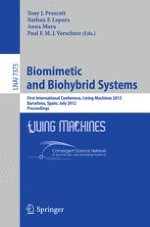2012 | Book
Biomimetic and Biohybrid Systems
First International Conference, Living Machines 2012, Barcelona, Spain, July 9-12, 2012. Proceedings
Editors: Tony J. Prescott, Nathan F. Lepora, Anna Mura, Paul F. M. J. Verschure
Publisher: Springer Berlin Heidelberg
Book Series : Lecture Notes in Computer Science
